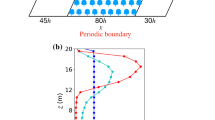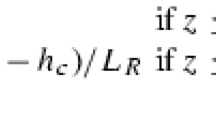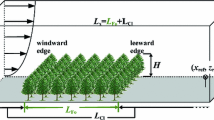Abstract
Modelling the transfer of heat, water vapour, and CO2 between the biosphere and the atmosphere is made difficult by the complex two-way interaction between leaves and their immediate microclimate. When simulating scalar sources and sinks inside canopies on seasonal, inter-annual, or forest development time scales, the so-called well-mixed assumption (WMA) of mean concentration (i.e. vertically constant inside the canopy but dynamically evolving in time) is often employed. The WMA eliminates the need to model how vegetation alters its immediate microclimate, which necessitates formulations that utilize turbulent transport theories. Here, two inter-related questions pertinent to the WMA for modelling scalar sources, sinks, and fluxes at seasonal to inter-annual time scales are explored: (1) if the WMA is to be replaced so as to resolve this two-way interaction, how detailed must the turbulent transport model be? And (2) what are the added predictive skills gained by resolving the two-way interaction vis-à-vis other uncertainties such as seasonal variations in physiological parameters. These two questions are addressed by simulating multi-year mean scalar concentration and eddy-covariance scalar flux measurements collected in a Loblolly pine (P. taeda L.) plantation near Durham, North Carolina, U.S.A. using turbulent transport models ranging from K-theory (or first-order closure) to third-order closure schemes. The multi-layer model calculations with these closure schemes were contrasted with model calculations employing the WMA. These comparisons suggested that (i) among the three scalars, sensible heat flux predictions are most biased with respect to eddy-covariance measurements when using the WMA, (ii) first-order closure schemes are sufficient to reproduce the seasonal to inter-annual variations in scalar fluxes provided the canonical length scale of turbulence is properly specified, (iii) second-order closure models best agree with measured mean scalar concentration (and temperature) profiles inside the canopy as well as scalar fluxes above the canopy, (iv) there are no clear gains in predictive skills when using third-order closure schemes over their second-order closure counterparts. At inter-annual time scales, biases in modelled scalar fluxes incurred by using the WMA exceed those incurred when correcting for the seasonal amplitude in the maximum carboxylation capacity (V cmax, 25) provided its mean value is unbiased. The role of local thermal stratification inside the canopy and possible computational simplifications in decoupling scalar transfer from the generation of the flow statistics are also discussed.
“The tree, tilting its leaves to capture bullets of light; inhaling, exhaling; its many thousand stomata breathing, creating the air”.
Ruth Stone, 2002, In the Next Galaxy
Similar content being viewed by others
References
Aber JD, Reich PB, Goulden ML (1996) Extrapolating leaf CO2 exchange to the canopy: a generalized model of forest photosynthesis compared with measurements by eddy correlation. Oecologia 106: 257–265
Andre JC, Lacarrere P, Traore K (1981) Pressure effects on triple correlations in turbulent convective flows. Turbulent shear flows III. Springer-Verlag, Berlin, pp 243–252
Baldocchi D (1992) A Lagrangian random-walk model for simulating water vapour, CO2 and sensible heat flux densities and scalar profiles over and within a soybean canopy. Boundary-Layer Meteorol 61: 113–144
Baldocchi D, Meyers T (1998) On using eco-physiological, micrometeorological and biogeochemical theory to evaluate carbon dioxide, water vapour and trace gas fluxes over vegetation: a perspetive. Agric Forest Meteorol 90: 1–25
Baldocchi DJ, Vogel C, Hall B (1997) Seasonal variation of carbon dioxide exchange rates above and below a boreal jack pine forest. Agric Forest Meteorol 83: 147–170
Baldocchi DD, Falge E, Gu L, Olson R, Hollinger D, Running S, Anthoni P, Bernhofer C, Davis K, Fuentes J, Goldstein A, Katul G, Law B, Lee X, Malhi Y, Meyers T, Munger JW, Oechel W, Pilegaard K, Schmid HP, Valentini R, Verma S, Vesala T, Wilson K, Wofsy S (2001) FLUXNET: a new tool to study the temporal and spatial variability of ecosystem-scale carbon dioxide, water vapour and energy flux densities. Bull Amer Meteorol Soc 82: 2415–2435
Ball JT, Woodrow IE, Berry JA (1987) A model predicting stomatal conductance and its contribution to the control of photosynthesis under different environmental conditions. In: Biggins J (eds) Progress in photosynthesis research. Martinus Nijhoff, Amsterdam Netherlands, pp 221–224
Brutsaert W (1975) On a derivable formula for long-wave radiation from clear skies. Water Resour Res 11: 742–744
Butnor JR, Johnsen KH (2004) Calibrating soil respiration measures with a dynamic flux apparatus using artificial soil media of varying porosity. Eur J Soil Sci 55: 639–647
Butnor JR, Johnsen KH, Oren R (2003) Reduction of forest floor respiration by fertilization on both carbon dioxide-enriched and reference 17-year-old loblolly pine stands. Global Change Biol 9: 849–861
Campbell GS (1986) Extinction coefficients for radiation in plant canopies calculated using an ellipsoidal inclination angle distribution. Agric Forest Meteorol 36: 317–321
Campbell GS, Norman JM (1998) An introduction to environmental biophysics. Springer-Verlag, New York, p 307
Collatz GJ, Ball JT, Crivet C, Berry JA (1991) Physiological and environmental regulation of stomatal conductance, photosynthesis and transpiration: a model that Includes a laminar boundary layer. Agric Forest Meteorol 54: 107–136
De Pury DGG, Farquhar GD (1997) Simple scaling of photosynthesis from leaves to canopies without the errors of big-leaf models. Plant Cell Environ 20: 537–557
Detto M, Katul GG (2007) Simplified expressions for adjusting higher-order turbulent statistics obtained from open path gas analyzers. Boundary-Layer Meteorol 122: 205–216
Ellsworth DS (1999) CO2 enrichment in a maturing pine forest: are CO2 exchange and water status in the canopy affected. Plant Cell Environ 22: 461–472
Ellsworth DS (2000) Seasonal CO2 assimilation and stomatal limitations in a Pinus taeda canopy. Tree Physiol 20: 435–445
Erbs DG, Klein SA, Duffie JA (1982) Estimation of the diffuse radiation fraction for hourly, daily and monthly average global radiation. Sol Energy 28: 293
Farquhar GD, Von Caemmerer S, Berry JA (1980) A biochemical model of photosynthetic CO2 assimilation in leaves of C3 species. Planta 149: 79–90
Goudriaan J, van Laar HH (1994) Modelling potential crop growth processes. Kluwer Academic Publishers, Dordrecht, p 256
Gu L, Shugart HH, Fuentes JD, Black TA, Shewchuk SR (1999) Micrometeorology, biophysical exchanges and NEE decomposition in a two-story boreal forest—development and test of an intergrated model. Agric Forest Meteorol 94: 123–148
Jackson PS (1981) On the displacement height in the logarithmic velocity profile. J Fluid Mech 111: 15–25
Juang J-Y, Katul GG, Siqueira MBS, Stoy PC, Palmroth S, McCarthy HR, Kim H, Oren R (2006) Modeling nighttime ecosystem respiration from measured CO2 concentration and air temperature profiles using inverse methods. J Geophys Res-Atmos 111: D08S05
Juang J-Y, Katul GG, Porporato A, Stoy PC, Siqueira M, Detto M, Kim H-S, Oren R (2007a) Eco-hydrological controls on summertime convective rainfall triggers. Global Change Biol 13(4): 887–896
Juang J-Y, Porporato A, Stoy PC, Siqueira MBS, Oishi CA, Detto M, Kim H-S, Katul GG (2007b) Hydrologic and atmospheric controls on initiation of convective precipitation events. Water Resour Res 43: W03421
Kaimal JC, Finnigan JJ (1994) Atmospheric boundary layer flows: their structure and measurements. Oxford University Press, 289 pp
Katul GG, Albertson JD (1998) An investigation of higher-order closure model for a forested canopy. Boundary-Layer Meteorol 89: 47–74
Katul GG, Chang WH (1999) Principal length scales in second-order closure models for canopy turbulence. J Appl Meteorol 38: 1631–1643
Katul GG, Leuning R, Oren R (2003) Relationship between plant hydraulic and biochemical properties derived from a steady-state coupled water and carbon transport model: Plant Cell Environ 26: 339–350
Katul GG, Mahrt L, Poggi D, Sanz C (2004) One and two equation models for canopy turbulence. Boundary-Layer Meteorol 113: 91–109
Kirschbaum MUF, Küppers M, Schneider HGC, Noe S (1998) Modelling photosynthesis in fluctuating light with inclusion of stomatal conductance, biochemical activation and pools of key photosynthetic intermediates. Planta 204: 16–26
Lai C-T, Katul GG, Oren R, Ellsworth D, Schafer K (2000a) Modeling CO2 and water vapour turbulent flux distributions within a forest canopy. J Geophys Res Atmos 105(D21): 26333–26351
Lai C-T, Katul GG, Ellsworth D, Oren R (2000b) Modelling vegetation-atmosphere CO2 exchange by a coupled Eulerian–Langrangian approach. Boundary-Layer Meteorol 95: 91–122
Lai C-T, Katul GG, Butnor JR, Siqueira M, Ellsworth DS, Maier C, Johnsen KH, McKeand S, Oren R (2002a) Modeling the limits on the response of net carbon exchange to fertilization in a southeastern pine forest. Plant Cell Environ 25: 1095–1119
Lai C-T, Katul GG, Butnor J, Ellsworth D, Oren R (2002b) Modelling night-time ecosystem respiration by a constrained source optimization method. Global Change Biol 8: 124–141
Leuning R, Kelliher FM, De Pury DGG, Schulze E-D (1995) Leaf nitrogen, photosynthesis, conductance and transpiration: scaling from leaves to canopies. Plant Cell Environ 18: 1183–1200
Leuning R (2000) Estimation of scalar sources/sink distributions in plant canopies using Lagrangian dispersion analysis: corrections for atmospheric stability and comparison with a multilayer canopy model. Boundary-Layer Meteorol 96: 293–314
Liu J, Black TA, Novak MD (1996) E-epsilon modeling of turbulent air flow downwind of a model forest edge. Boundary-Layer Meteorol 77: 21–44
Luo Y, Medlyn B, Hui D, Ellsworth DS, Reynolds JF, Katul G (2001) Gross primary productivity in the Duke forest: modeling synthesis of the free-air CO2 enrichment experiment and eddy-covariance measurements. Ecol Appl 11: 239–252
Malhi Y, Nobre AD, Grace J, Kruijt B, Pereira MGP, Culf A, Scott S (1998) Carbon dioxide transfer over a Central Amazonian rain forest. J Geophys Res Atmos 103: 31593–31612
Massman WJ, Weil JC (1999) An analytical one-dimensional second-order closure model of turbulence statistics and the Lagrangian time scale within and above plant canopies of arbitrary structure. Boundary-Layer Meteorol 91: 81–107
McCarthy HR, Oren R, Finzi AC, Johnsen KH (2006a) Canopy leaf area constrains [CO2]-induced enhancement of productivity and partitioning among aboveground carbon pools. Proc Natl Acad Sci USA 103: 19356–19361
McCarthy HR, Oren R, Kim H-S, Johnsen KH, Maier C, Pritchard SG, Davis MA (2006b) Interaction of ice storms and management practices on current carbon sequestration in forests with potential mitigation under future CO2 atmosphere. J Geophys Res Atmos 111: D15103
McCarthy HR, Oren R, Finzi AC, Ellsworth DS, Kim H-S, Johnsen KH, Millar B (2007) Temporal dynamics and spatial variability in the enhancement of canopy leaf area under elevated atmospheric CO2. Global Change Biol 13: 2479–2497
Mellor G (1973) Analytic prediction of the properties of stratified planetary boundary layer. J Atmos Sci 30: 1061–1069
Meyers T, Paw UKT (1986) Testing of a higher-order closure model for modeling airflow within and above plant canopies. Boundary-Layer Meteorol 37: 297–311
Meyers T, Paw UKT (1987) Modeling the plant canopy micrometeorology with higher-order closure principles. Agric Forest Meteorol 41: 143–163
Naumburg E, Ellsworth DS (2000) Photosynthetic sunfleck utilization potential of understory saplings growing under elevated CO2 in FACE. Oecologia 122: 163–174
Naumburg E, Ellsworth DS, Katul GG (2001) Modeling daily understory photosynthesis of species with differing photosynthetic light dynamics in ambient and elevated CO2. Oecologia 126: 487–499
Nikolov NT, Massman WJ, Schoettle AW (1995) Coupling biochemical and biophysical processes at the leaf level: an equilibrium photosynthesis model for leaves of C3 plants. Ecol Model 80: 205–235
Oren R, Ewers B, Todd P, Phillips N, Katul GG (1998) Water balance delineates the soil layer in which moisture affects canopy conductance. Ecol Appl 8: 990–1002
Palmroth S, Maier CA, McCarthy HR, Oishi AC, Kim H-S, Johnsen KH, Katul GG, Oren R (2005) Contrasting responses to drought of forest floor CO2 efflux in a loblolly pine plantation and a nearby oak-hickory forest. Global Change Biol 11: 1–14
Pataki DE, Oren R (2003) Species differences in stomatal control of water loss at the canopy scale in a mature bottomland deciduous forest. Adv Water Resour 26(12): 1267–1278
Pataki DE, Oren R, Tissue D (1998) Elevated carbon dioxide does not affect average canopy stomatal conductance of Pinus taeda L. Oecologia 127: 549–559
Penman HL (1948) Natural evaporation from open water, bare soil and grass. Proc Roy Soc London Ser A 193: 120–146
Poggi D, Katul GG, Albertson JD (2004) Momentum transfer and turbulent kinetic energy budgets within a dense model canopy. Boundary-Layer Meteorol 111: 589–614
Raupach MR (1988) Canopy transport processes. In: Steffen WL, Denmead OT (eds) Flow and transport in the natural environment: advances and applications. Springer-Verlag, New York, pp 95–127
Raupach MR (1989) A practical Lagrangian method for relating scalar concentrations to source distributions in vegetation canopies. Quart J Roy Meteorol Soc 115: 609–632
Schafer KVR, Oren R, Ellsworth DS, Lai C-T, Herrick JD, Finzi AC, Richter DD, Katul GG (2003) Exposure to an enriched CO2 atmosphere alters carbon assimilation and allocation in a pine forest ecosystem. Global Change Biol 9: 1378–1400
Shaw RH, Hartog GD, Neumann HH (1988) Influence of foliar density and thermal stability on profiles of Reynolds stress and turbulence intensity in a deciduous forest. Boundary-Layer Meteorol 45(4): 391–409
Simon E, Meixner FX, Ganzeveld L, Kesselmeier J (2005a) Coupled carbon-water exchange of the Amazon rain forest, I. Model description, parameterization and sensitivity analysis. Biogeosciences 2: 231–253
Simon E, Meixner FX, Rummel U, Ganzeveld L, Ammann C, Kesselmeier J (2005b) Coupled carbon-water exchange of the Amazon rain forest, II. Comparison of predicted and observed seasonal exchange of energy, CO2, isoprene and ozone at a remote site in Rondônia. Biogeosciences 2: 255–275
Siqueira M, Katul G (2002) Estimating heat sources and fluxes in thermally stratified canopy flows using higher-order closure models. Boundary-Layer Meteorol 103: 125–142
Siqueira M, Kutal GG, Lai C-T (2002) Quantifying net ecosystem exchange by multilevel ecophysiological and turbulent transport models. Adv Water Resour 25: 1357–1366
Spitters CJT, Toussaint HAJM, Goudriaan J (1986) Separating the diffuse and direct component of global radiation and its implications for modelling canopy photosynthesis. Part I. Components of incoming radiation. Agric Forest Meteorol 38: 225–237
Spitters CJT (1986) Separating the diffuse and direct component of global radiation and its implications for modelling canopy photosynthesis. Part II. Calculation of canopy photosynthesis. Agric Forest Meteorol 38: 238–241
Stenberg P (1998) Implications of shoot structure on the rate of photosynthesis at different levels in a coniferous canopy using a model incorporating grouping and penumbra. Funct Ecol. 12: 82–91
Stoy P, Katul GG, Siqueira MBS, Juang J-Y, McCarthy HR, Kim H-S, Oishi C, Oren R (2005) Variability in net ecosystem exchange from hourly to inter-annual time scales at adjacent pine and hardwood forests: a wavelet analysis. Tree Physiol 25: 887–902
Stull RB (1988) An introduction to boundary layer meteorology. Kluwer Academic Publishers Group, Dordrecht, p 666
Su H-B, Paw UKT, Shaw RH (1996) Development of a coupled leaf and canopy model for the simulation of plant-atmosphere interaction. J Appl Meteorol 35: 733–748
Thom AS (1971) Momentum absorption by vegetation. Quart J Roy Meteorol Soc 97: 414–428
Wang YP, Leuning R (1998) A two-leaf model for canopy conductance, photosynthesis and partitioning of available energy I: Model description and comparison with a multi-layered model. Agric Forest Meteorol 91: 89–111
Webb EK, Pearman GI, Leuning R (1980) Correction of flux measurements for density effects due to heat and water vapour transfer. Quart J Roy Meteorol Soc 106: 85–100
Weiss A, Norman JM (1985) Partitioning solar radiation into direct and diffuse, visible and near-infrared components. Agric Forest Meteorol 34: 205–213
Williams M, Rastetter EB, Fernades DN, Goulden MLC, Wofsy S, Shaver GR, Meillo JM, Munger JW, Fan SM, Nadelhoffer KJ (1996) Modeling the soil–plant–atmosphere continuum in a Quercus-Acerstand at Harvard forest: the regulation of stomatal conductance by light, nitrogen and soil/plant hydraulic properties. Plant Cell Environ 19: 911–927
Williams M, Malhi Y, Nobre AD, Rastetter EB, Grace J, Pereira MGP (1998) Seasonal variation in net carbon exchange and evapotranspiration in a Brazilian rain forest: a modelling analysis. Plant Cell Environ 21: 953–968
Wilson JD et al (1989) Turbulent transport within the plant canopy. In: Blackman TA (eds) Estimation of areal evapotranspiration. IAHS Pub., Gentbrugge, Belgium, pp 43–80
Wilson NR, Shaw RH (1977) A higher order closure model for canopy flow. J Appl Meteorol 16: 1198–1205
Author information
Authors and Affiliations
Corresponding author
Rights and permissions
About this article
Cite this article
Juang, JY., Katul, G.G., Siqueira, M.B. et al. Investigating a Hierarchy of Eulerian Closure Models for Scalar Transfer Inside Forested Canopies. Boundary-Layer Meteorol 128, 1–32 (2008). https://doi.org/10.1007/s10546-008-9273-2
Received:
Accepted:
Published:
Issue Date:
DOI: https://doi.org/10.1007/s10546-008-9273-2




